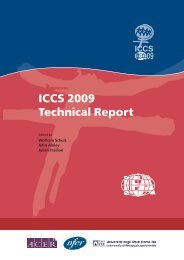Teacher Education and Development Study in Mathematics - IEA
Teacher Education and Development Study in Mathematics - IEA
Teacher Education and Development Study in Mathematics - IEA
Create successful ePaper yourself
Turn your PDF publications into a flip-book with our unique Google optimized e-Paper software.
PART 2: BULGARIA<br />
63<br />
To assess the relative salaries <strong>in</strong> teach<strong>in</strong>g <strong>and</strong> how these are chang<strong>in</strong>g over time, we<br />
used the 1995 <strong>and</strong> 2001 Bulgaria Integrated Household Survey (BIHS), conducted by<br />
BBSS Gallup International under World Bank supervision. The samples <strong>in</strong> both years<br />
consisted of 2,500 households <strong>and</strong> were nationally representative. The 2001 survey<br />
over-sampled 133 Roma households.<br />
The small sample size <strong>in</strong> Bulgaria means that any conclusions drawn from our f<strong>in</strong>d<strong>in</strong>gs<br />
are tentative. Also, the occupational category that <strong>in</strong>cludes teachers also <strong>in</strong>cludes<br />
education managers, although the salary levels suggest that almost all <strong>in</strong> the category<br />
were teachers. Despite these limitations, the age-earn<strong>in</strong>gs profiles show that, <strong>in</strong> 1995,<br />
female teachers/managers earned more than eng<strong>in</strong>eers/technicians (but less than<br />
accountants). This was not the case for males. Both female teachers/managers <strong>and</strong> male<br />
teachers/managers lost ground to compet<strong>in</strong>g occupations between 1995 <strong>and</strong> 2001. This<br />
was especially true for young males <strong>and</strong> all female teachers (see Table 15 <strong>and</strong> Figures 9<br />
to 12).<br />
When we translate the monetary values <strong>in</strong> Table 15, which are <strong>in</strong> current leva, <strong>in</strong>to<br />
current dollars, us<strong>in</strong>g the average exchange rates of 1995 <strong>and</strong> 2001, we see that although<br />
average earn<strong>in</strong>gs <strong>in</strong> US dollars rose between 1995 <strong>and</strong> 2001 (Table 16), the ga<strong>in</strong>s for<br />
teachers were not as large as they were for eng<strong>in</strong>eers/technicians. If the earn<strong>in</strong>gs we have<br />
estimated for Bulgaria are reasonably accurate, we can surmise that Bulgaria will have<br />
far greater difficulty recruit<strong>in</strong>g mathematics teachers over the com<strong>in</strong>g years than it did<br />
<strong>in</strong> the 1980s <strong>and</strong> early 1990s. Either the quality of mathematics teach<strong>in</strong>g <strong>in</strong> Bulgaria will<br />
decl<strong>in</strong>e, or teacher salaries will have to rise.<br />
Table 15: Bulgaria, Mean Monthly Earn<strong>in</strong>gs of <strong>Teacher</strong>s/Managers, Eng<strong>in</strong>eers/Technicians, <strong>and</strong> Accountants<br />
with University <strong>Education</strong>, by Gender, 1995 <strong>and</strong> 2001 (current Bulgarian leva)<br />
Males with University <strong>Education</strong>, 1995 Females with University <strong>Education</strong>, 1995<br />
Age <strong>Teacher</strong>s/Managers Eng<strong>in</strong>eers/ Accountants <strong>Teacher</strong>s/Managers Eng<strong>in</strong>eers/ Accountants<br />
Technicians<br />
Technicians<br />
20–24 4,380<br />
25–29 6,200 8,298 3,908 4,425<br />
30–34 4,450 8,636 35,505 4,675 4,350 7,352<br />
35–44 5,050 9,483 8,830 4,775 4,202 6,900<br />
45–54 5,000 13,023 7,050 4,700 5,658 6,564<br />
55–64 6,800 15,162<br />
Males with University <strong>Education</strong>, 2001 Females with University <strong>Education</strong>, 2001<br />
Age <strong>Teacher</strong>s/Managers Eng<strong>in</strong>eers/ Accountants <strong>Teacher</strong>s/Managers Eng<strong>in</strong>eers/ Accountants<br />
Technicians<br />
Technicians<br />
20–24 230<br />
25–29 153 300 315 175 214<br />
30–34 153 461 527 162 183 196<br />
35–44 226 275 215 160 211 222<br />
45–54 268 300 300 176 267 231<br />
55–64 172 225 270 224 235<br />
Source: Estimated from Gallup International, Bulgaria Integrated Household Survey, 1995; Bulgaria Integrated Household<br />
Survey, 2001 (http://www.worldbank.org/lsms/country/bg01/bg01docs.html).

















